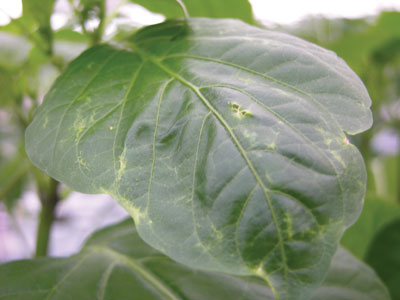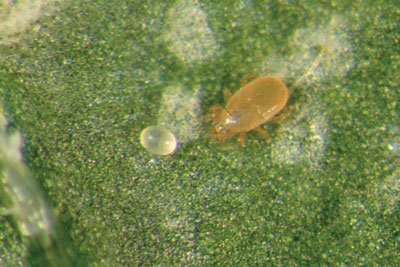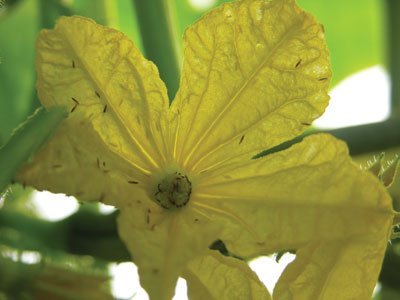
Features
Biocontrols
Inputs
Early season biocontrol of WFT
April 28, 2011 By Gillian Ferguson and Dr. Les Shipp
Though many biocontrol programs for western flower thrips (WFT) in
greenhouse vegetables are successful, this pest is often a challenge to
manage, particularly when incidence begins early in the season. Part of
the challenge lies in the lack of pesticide options that can quickly
suppress populations while allowing biocontrol agents to establish a
favourable predator/pest ratio. Despite this, many growers are able to
successfully manage WFT populations by adhering to two key management
recommendations as follows:

|
| Damage on pepper leaf due to feeding damage by western flower thrips. (Photos Courtesy Gillian Ferguson, OMAFRA)
|
Though many biocontrol programs for western flower thrips (WFT) in greenhouse vegetables are successful, this pest is often a challenge to manage, particularly when incidence begins early in the season. Part of the challenge lies in the lack of pesticide options that can quickly suppress populations while allowing biocontrol agents to establish a favourable predator/pest ratio. Despite this, many growers are able to successfully manage WFT populations by adhering to two key management recommendations as follows:
- A really good cleanup between crops.
- Proper use of biocontrol agents.
 |
|
| Predatory mite (Amblyseius sp.) and recently laid egg. | |
 |
|
| Cucumber flower infested with western flower thrips.
|
CLEANUP STRATEGY FOR WFT
The key strategy to cleaning up WFT at the end of a crop is to remove not just the mobile stages (adults and larval stages on leaves), but also the pupal stages, and most especially, the pupal stages.
The majority of greenhouse vegetable operations implements a good cleanup at the end of the year before establishing the spring crop. Crop removal and disinfection at the end of the crop would certainly remove the majority of the mobile WFT from an infested crop.
However, growers often forget about the pupal stages of WFT. These stages are quiescent, non-feeding, mostly on the ground, and likely, often under the floor cover, and therefore, well hidden. Furthermore, pupae of WFT are not very susceptible to pesticides and therefore it’s necessary to leave sufficient time while maintaining warm temperatures to promote the transition from pupa to adult, a much more susceptible stage to cleanup procedures.
The time taken for completion of the pupal stages is just three days at 30°C, about 5 days at 20°C, and 8.5 days at 15°C. This development time must be considered during cleanup to reduce WFT populations adequately. In essence, the cooler the house during cleanup, the higher the likelihood of thrips survival and of carryover to the next crop.
PROPER USE OF BIOCONTROLS
Proper use of biocontrols means release of adequate numbers of biocontrol agents in a timely manner on the crop. Biocontrols currently available for managing WFT include predatory mites (Amblyseius spp., Hypoaspis sp.), a predatory bug (Orius), a rove beetle (Atheta sp.), and the fungal insecticide, Beauveria bassiana (Botanigard®). However, the principal biocontrols used during the early part of the season are Amblyseius cucumeris, A. swirskii, and B. bassiana.
Timing of release of predatory mites – Usually, the earlier that releases are done, the better. The main reason for early release of predatory mites is the lag that exists between release and establishment, particularly when sachets are used.
Research done at the Greenhouse and Processing Crops Research Centre (GPCRC), Harrow, Ont., (Shipp et al., 2003) indicates that the numbers of A. cucumeris emerging from sachets increase gradually during the first three weeks, and then decline thereafter over the next three weeks. This means that while predators are slowly emerging from sachets on an infested crop, thrips will have the advantage in having a few more weeks to multiply before they might encounter any predators. Therefore, the slow release of predators onto a crop may not be able to cope with the existing thrips population, resulting in a net increase in thrips levels.
Distribution of predatory mites – Another important factor in successful use of predatory mites is their distribution on the crop. Early in the season when plants are not yet touching, sparsely distributed predatory mites would be unable to spread throughout a crop in a timely manner. Given that predatory mites are wingless and therefore cannot fly, and are not known to hop, and that there is a large surface area on each plant to be searched, there is often a delay before predatory mites move from one plant to a neighbouring one.
If, over and above these factors, there is a gap between plants, distribution of predatory mites will be hindered even further, resulting in a thrips population increase on those plants that have no predatory mites on them. Such delay in spread of predatory mites and population increase of thrips on “unprotected” plants often leads to excessive thrips numbers and crop damage.
How many predatory mites to release? – The numbers and methods (sachets and bulk distribution) of release depend on thrips population levels, type of crop, and stage of crop. Generally, the more generous the quantity released, the greater the chances of successful suppression.
For example, thrips on tomato crops are probably the most difficult to suppress of all the vegetable crops. However, work done at the GPCRC, Harrow, Ont., (Shipp et al., 2003) showed that using one sachet of A. cucumeris per plant at four-week intervals significantly reduced thrips levels five weeks after the initial release. At the end of the trial, the untreated control plants had 78 per cent more thrips than plants treated with the sachets.
Similar results were obtained in greenhouse cucumbers in the U.K. when plants were infested with about 20 WFT and one sachet of A. cucumeris was used per plant. Such results demonstrate that thrips can be overcome, even at high population levels, given sufficient numbers of predators.
Releasing adequate numbers of predatory mites is particularly important during the winter months. Work done at GPCRC, Harrow, Ont., (Zilahi-Balogh et al., 2006) revealed that A. cucumeris killed significantly less thrips at temperatures of 20°C versus 24°C, and furthermore, it laid fewer eggs under low light conditions. These two factors combined could result in poor or delayed establishment of predatory mites during the winter months.
A. cucumeris vs. A. swirskii – A. cucumeris has been the mainstay for many years for thrips control in greenhouse vegetables. A. swirskii has been in use commercially for just a few years and has produced outstanding results in many instances. Although most of the reported research has been done on A. cucumeris, we believe that many of the principles advocated above apply to these two predatory mites, more or less, equally.
Use of Beaveria bassiana – This fungal insecticide controls insects by growing on them, secreting enzymes that weaken the insect’s outer coat, and then getting inside the insect and continuing to grow, eventually killing the infected pest. Good suppression using this microbial product has been observed particularly when application intervals were about two to three days apart. Depending on population levels of thrips, at least six applications are often necessary to observe a significant reduction in numbers of thrips.
1. Gillian Ferguson, Greenhouse Vegetable IPM Specialist, Ontario Ministry of Agriculture, Food and Rural Affairs, Harrow, Ont.; gillian.ferguson@ontario.ca.
2. Les Shipp, Greenhouse Entomologies, Agriculture and Agri-Food Canada, Harrow, Ont.; les.shipp@agr.gc.ca.
Print this page